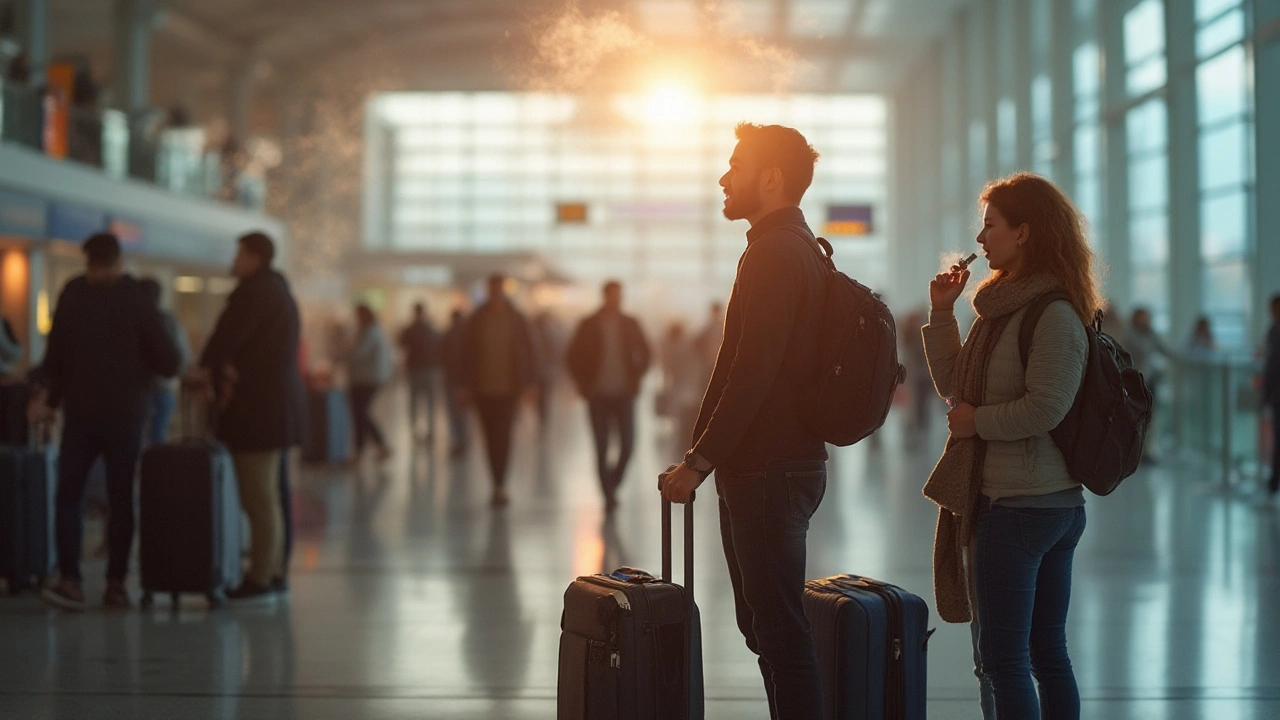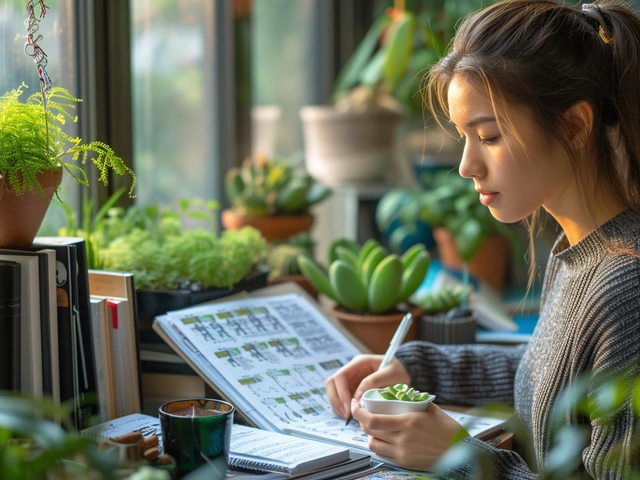If you’ve ever found yourself stuck on a delayed flight, trying not to fidget as cranky kids wail behind you, and thinking, “Why didn’t I just drive?”—you're not alone. Add jet lag, stiff muscles, and that all-too-familiar hotel room smell, and traveling can feel more like a test of endurance than a vacation. That’s where aromatherapy turns the tables. Sure, essential oils won’t change your flight’s departure time, but they can absolutely shift your mood, soothe nerves, and help your body catch up—no matter where you land. The best part? They fit right in your pocket, between stray boarding passes and packs of gum.
Why Aromatherapy Makes a Difference During Travel
Stress levels are known to jump about 30% when you travel, according to a 2024 Statista survey on leisure travelers. Factors like unexpected delays, unfamiliar beds, and cramped seats spike your body’s cortisol—your main stress hormone. Aromatherapy steps in as an easy, no-prescription-needed tool to dial the tension back. Here’s how it works: as you inhale the scent molecules from essential oils, your olfactory system signals the limbic area of your brain—the part responsible for emotions, memory, and even heart rate. So a single whiff can set off a whole cascade that makes you calmer, more focused, or even less nauseated.
Peppermint, for example, is more than your grandma’s favorite candy flavor; it’s clinically proven to calm queasy stomachs and boost alertness (University of Maryland Medical Center, 2022). Lavender? One 2023 meta-analysis published in the Journal of Travel Medicine found that travelers using lavender essential oil slept 25% better than those in the control group. Want a practical tip? Mix a couple of drops into a travel-friendly roll-on or bring pre-diluted ones to dab on your wrists and temples—no mess, no liquids drama at airport security.
Besides the mood shifts, aromatherapy can fight environment-related issues while on the move: dry airplane air, musty train cars, or that oddly industrial smell of a taxi cab. I keep a tiny atomizer of eucalyptus in my carry-on. Spritzing it on the headrest or collar clears the nose and perks me up during red-eye flights. In fact, a 2023 American Airlines trial found that incorporating eucalyptus-infused towels in business class improved passenger ratings by 12%. Clearly, the right scent can change how we feel and experience the world—especially when we're far from home.
| Essential Oil | Main Benefit | Common Travel Uses |
|---|---|---|
| Lavender | Calms nerves, aids sleep | Jet lag, sleep in hotels |
| Peppermint | Boosts alertness, soothes motion sickness | Long car rides, headaches |
| Eucalyptus | Decongests airways, refreshes | Stale air on airplanes |
| Ginger | Soothes nausea | Cruise ships, road trips |
| Sweet Orange | Uplifts mood, energizes | Mood dips, energy slumps |

Building Your Travel Aromatherapy Kit
If you start browsing online for "travel aromatherapy kits," you’ll see all kinds of pricey sets. Honestly, you only need a few solid oils and the right tools to make a huge difference. My personal go-to for any trip (even just a day at the dog park with Rusty!) includes aromatherapy for travel favorites: lavender, peppermint, and orange. Why those? Because they've got wide coverage—lavender for winding down, peppermint for perking up, and orange for keeping my mood sunny even if I’m running on airport food and four hours of sleep.
Here’s what to consider when building your kit:
- Roll-ons or Inhalers: Roller bottles keep things spill-proof. There are even disposable "sniff sticks"—little inhalers you can stash in your pocket.
- Mini Spritz Bottles: Mix a couple drops of oil in water for a fabric or room spray. These work wonders on musty hotel pillows and airplane neck pillows.
- Blotting Papers or Cotton Pads: These let you drip oils for a quick hit without carrying any glass bottles. Seal in a zip-top bag, and you’re set.
- Carrier Oil: Always dilute oils like peppermint or eucalyptus with a base, like sweet almond or jojoba oil, especially if you’re putting them on your skin.
Now, let’s talk travel safety. TSA still has its liquid rules—so every oil and blend should be under 100 ml and in a see-through bag. Want to dodge leaks? Choose tightly sealed bottles with dropper tops or roll-ons. And always—always—label your bottles. Nobody enjoys a surprise aromatherapy challenge when you can’t tell lemon from tea tree on three hours of shut-eye.
Keep in mind that some oils—like citrus—are photosensitive and can make your skin more sensitive to the sun. So if beach lounging is on your schedule, avoid applying orange directly before stepping out. And if you’re traveling with pets (Rusty gives this tip two paws up), check that your oil picks are safe for animals; for example, dogs can tolerate lavender and ginger in tiny doses, but tea tree and eucalyptus can be toxic. Better safe than sorry, especially if you travel like me and your pup’s your sidekick.
Curious about how others use aromatherapy when on the go? According to a 2023 survey by the American Holistic Nurses Association, nearly 44% of regular travelers pack some form of essential oil with them—most citing stress management as the top benefit, followed by help with headaches and sleep. People have even started swapping travel-size hand sanitizers for lavender wipes. The trick is a little creativity, reading the room (or plane), and picking blends that make you feel at home anywhere.

Pro Tips and Clever Uses for Essential Oils on the Go
Let’s get practical. If you’re sitting in a packed coach section and pulling out a diffuser in the middle of your row, let’s be honest, you’ll get a few glares. But with a little subtlety, you can enjoy all the benefits without bothering anyone else. Here are my favorite hacks that I’ve tested across three continents (and countless hotel rooms):
- Portable diffuser necklaces: Tiny lockets with felt pads. Add a drop or two of your oil and wear the scent all day—especially good if your seat mate would rather you didn’t spritz the air.
- Aroma-infused masks: Add a drop of peppermint or eucalyptus to the edge of your travel mask. It makes stale cabin air way easier to tolerate—and can even mask the smell of reheated airplane food.
- Pillow and linen sprays: Turn that lumpy hotel pillow into a lavender spa by giving it a quick spritz before you crash each night.
- Mood rescue wipes: Make your own by adding a few drops of orange or lavender to pre-moistened wipes. Use them to freshen hands, phone screens, or just perk up after a long layover.
- Massage on the go: If you land with a sore neck or headache, rub diluted peppermint oil onto the back of your neck and temples. That cool, tingly feeling? Instant relief—and it beats hunting down an overpriced spa in a tourist zone.
- Window & Vent Helpers: On a bus or train, dab a bit of oil onto the cloth near your seat or AC vent. The gentle airflow spreads the scent without overpowering your neighbor.
There’s a real reason seasoned flight attendants slip essential oils into their pockets. A 2022 Southwest Airlines crew survey found that using personal aromatherapy lowered perceived jet lag by at least one point on a standard alertness mood scale. Old-school travel writers used to suggest a splash of cologne for similar reasons, but we know now that pure essential oils do much more—helping with germs, inflammation, and clear thinking in unfamiliar environments.
Ever had trouble getting sleepy on those first nights in a different time zone? Try this bedtime routine: a warm compress with lavender and a cup of chamomile tea. One small 2024 pilot study out of NYU found that combining scent and warmth led to longer REM cycles (that’s the good, restful sleep phase) after just two nights abroad. If lavender’s not your thing, try cedarwood or ylang ylang—both have compounds shown to relax the central nervous system.
If your skin is sensitive or reactive—mine often is after plane rides—skip direct application and use a diluted spray instead. Or simply inhale the oil straight from the cap. And never underestimate the power of a "scent talisman"—a favorite blend tucked away in your scarf or sleeve that reminds you of home, or calm, or your last adventure hiking the Smoky Mountains.
Last tip: go slow with new oils, especially in stuffy public spaces. Start with less than you think you need. Strong oils can easily overwhelm, and your goal is serenity, not clearing the aircraft with a cloud of menthol. People process scent differently, and what’s comforting to you might be a headache trigger to someone else. Respect your fellow travelers and, when in doubt, stick to personal application.






